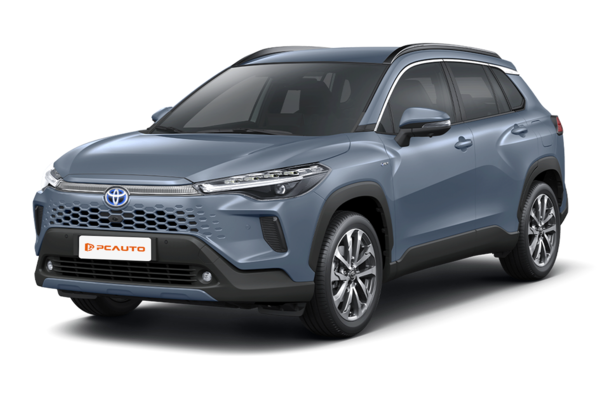Q
What is a 2019 Honda Jazz worth?
The used market price for the 2019 Honda Jazz typically ranges from RM50,000 to RM70,000, with the exact figure depending on factors like vehicle condition, mileage, trim level, and service history. The high-spec V trim or hybrid version can cost around 10% to 15% more than the base models. This car has always been popular in the used car market thanks to the reliability and fuel efficiency of its 1.5-liter i-VTEC engine, plus the flexible Ultra Seats design. It's recommended to check the vehicle's accident history and engine condition through Honda's official channels or third-party inspection agencies before purchasing. Also, note that the 2019 model belongs to the later production run of the third-generation Jazz, which saw improvements in sound insulation and suspension tuning compared to earlier versions. If your budget is tight, consider 2017-2018 models, which are RM10,000 to RM15,000 cheaper, but be aware that some of these might be approaching the 5-year mark and may require more replacement of wear-and-tear parts.
Q
What is the mileage of Honda Jazz 2019?
The 2019 Honda Jazz excels in fuel efficiency, with specific consumption figures varying by powertrain and driving conditions. The 1.5-liter i-VTEC gasoline engine variant delivers a combined fuel economy of approximately 5.5 to 6.0 liters per 100 kilometers, while the hybrid version (where available) achieves even lower fuel consumption. This car continues the Jazz lineup's legacy of flexible space and practicality; despite its compact exterior, the interior features clever design, and the Magic Seat system easily adapts to various cargo needs. In real-world use, fuel economy is influenced by road conditions, driving habits, and maintenance status. It's advisable to perform regular maintenance and check tire pressure to ensure optimal fuel efficiency. When considering a used Jazz, it's recommended to verify the actual mileage through complete service records and pay attention to the condition of key components like the engine and transmission. Among its peers, the Jazz consistently maintains good resale value and reliability, making it suitable for urban commuting and family daily use.
Q
What is the power of Honda Jazz 2019?
The 2019 Honda Jazz comes with a 1.5-liter i-VTEC naturally aspirated engine locally, churning out 120 horsepower (around 89 kW) and 145 Nm of peak torque. It's paired with either a CVT or a 6-speed manual gearbox, delivering smooth, fuel-efficient performance that's perfect for city driving. Built on Honda's classic global small car platform, the Jazz features lightweight construction combined with Earth Dreams technology, resulting in impressive fuel economy—around 5.5L/100km combined. What really stands out is its "Magic Seat" design; despite being a small car, the interior flexibility beats most rivals. Fold the rear seats flat, and you get a huge cargo area. Safety-wise, it gets VSA vehicle stability control, HSA hill-start assist, and higher trims even come with the Honda SENSING active safety suite. When stacked against competitors like the Toyota Yaris and Mazda2, the Jazz holds its own in power figures, but Honda's edge in space utilization and resale value is what keeps it a long-time favorite. If you crave more pep, keep an eye out for the later Jazz RS sport variant, which gets a more performance-focused tune.
Q
What is the price of Honda Jazz in 2019?
Prices for the 2019 Honda Jazz in local markets vary by trim level. The base 1.5E manual starts around RM70,000, while the top-spec 1.5V Sensing CVT gets close to RM90,000 – exact figures might shift with dealer promotions or optional extras. It keeps Honda's classic practical design, packing a 1.5-liter i-VTEC engine with Earth Dreams tech that balances fuel efficiency with 131 hp, making it perfect for city drives. The standout feature? Jazz's iconic ULTRA seat system with its multiple folding setups – fold the rear seats down and you get a completely flat cargo area. That "magic seat" space concept still shines in its class. The 2019 model also added Honda SENSING on higher trims, bringing features like collision mitigation braking and lane keep assist – pretty advanced stuff for its segment back then. Looking at the used market, the 2019 Jazz holds value steadily. Well-maintained examples typically retain about 60-70% of their original price, thanks to its solid reliability reputation and affordable upkeep costs.
Q
What engine is in the 2019 Honda Jazz?
The 2019 Honda Jazz offers two engine options locally: 1.3-liter and 1.5-liter i-VTEC naturally aspirated gasoline engines. The 1.3-liter unit, coded L13B, delivers 98 horsepower and 127 Nm of torque, while the 1.5-liter (L15B) puts out 118 horsepower and 145 Nm. Both pair with a CVT transmission, balancing smoothness and fuel efficiency. Honda's i-VTEC tech smartly adjusts valve timing and lift to optimize power delivery and fuel economy across different RPM ranges, making it perfect for city driving. What's cool is the Jazz's front-engine, front-wheel-drive layout, combined with Honda's famous "MM Concept" (Maximizing Man Space, Minimizing Machine Space), which results in seriously impressive interior space utilization. In its class, the Jazz stands out for its proven, reliable engine tech, relatively low maintenance costs, and strong resale value—definitely a solid pick for buyers who prioritize practicality and economy. If you're craving more power, keep an eye out for the Jazz RS variant that came later; its 1.5-liter engine gets special tuning for even better performance.
Q
How much horsepower does a 2019 Honda Jazz have?
The 2019 Honda Jazz comes locally with a 1.5-liter i-VTEC naturally aspirated engine, churning out 120 horsepower and 145 Nm of peak torque, paired with a CVT transmission. It delivers smooth, fuel-efficient performance that's perfect for city driving. This car has gained popularity for its flexible interior space and reliability. Even though it's a naturally aspirated unit, the i-VTEC tech does a solid job balancing low-end torque and high-rev power, making it more than enough for daily use. If you want to know more about its performance, the chassis is tuned for comfort, with suspension that effectively soaks up road bumps. Meanwhile, the body rigidity is good, and cornering stability is above average for its class. Plus, the Magic Seat design makes the trunk space super versatile—great for families or anyone who needs to haul stuff regularly. Turbo engines are all the rage these days, but naturally aspirated ones like this Jazz's have lower maintenance costs and proven durability over time. For buyers on a budget or who prioritize practicality, this is a solid pick.
Q
What is the fuel consumption of Honda Jazz 2019?
The fuel efficiency of the 2019 Honda Jazz varies depending on the powertrain. The version equipped with the 1.5-liter i-VTEC naturally aspirated engine delivers an average combined fuel consumption of approximately 5.4 to 5.8 liters per 100 kilometers, while the Hybrid model achieves an even lower 4.5 to 4.8 liters per 100 kilometers. Actual figures may fluctuate based on driving habits, road conditions, and vehicle maintenance status. This car utilizes Honda's Earth Dreams technology, optimizing fuel economy through a lightweight body and efficient transmission system, making it ideal for city commuting. To further reduce fuel consumption, it is recommended to maintain a steady speed, avoid sudden acceleration and hard braking, and regularly replace the air filter and spark plugs. In the same class, models with similar fuel efficiency include the Toyota Yaris, but the Jazz is favored by many consumers for its flexible interior space and reliability. Notably, hybrid models can significantly save fuel in congested traffic through electric motor assistance, making them more economical in the long run.
Q
Does the 2018 Honda City have parking sensors?
The 2018 Honda City does come with parking sensors in some trim levels, but whether a specific model has them depends entirely on its actual specs and configuration grade. Higher-end variants typically feature front and rear parking sensors to help drivers park more safely and conveniently. These sensors use ultrasonic technology to detect distances to obstacles, alerting drivers with audio or visual cues—super handy in crowded city areas or tight parking spots. Beyond parking sensors, many modern cars also offer reverse cameras or even 360-degree surround-view systems, which take parking safety up another notch. If you're looking at a used model or considering upgrading features, it's best to check the vehicle in person or consult a dealer to confirm what's included. You might also want to ask about other driver-assist tech like automatic parking or blind-spot monitoring, as availability can vary between model years and trims.
Q
What is the fuel consumption of Honda City 2018?
The fuel economy of the 2018 Honda City varies by powertrain. The version with the 1.5-liter i-VTEC naturally aspirated engine averages around 5.4 to 5.8 liters per 100 kilometers in combined driving, while the RS trim with the 1.5-liter Earth Dreams turbocharged engine is slightly higher at approximately 6.2 liters per 100 kilometers. Actual figures can fluctuate based on driving habits, road conditions, and maintenance status. Equipped with a CVT transmission that optimizes fuel efficiency, paired with an ECO mode for further savings, this car suits city commuting well. To boost fuel economy, regular maintenance like air filter replacements and using the recommended viscosity oil is advisable, along with avoiding aggressive acceleration or speeding. In its class, fuel efficiency ties closely to engine technology and lightweight design—some competitors achieve lower consumption through direct injection or hybrid systems, yet the Honda City remains popular for its reliability and strong after-sales network. Additionally, keeping tire pressure at the manufacturer's recommended levels and reducing idle warm-up time are small details that can marginally improve fuel economy.
Q
What is the fuel capacity of Honda City 2018?
The 2018 Honda City comes with a 40-liter fuel tank, a design that balances daily commuting and short to medium-distance travel needs. Paired with its efficient 1.5-liter i-VTEC petrol engine or 1.5-liter Earth Dreams diesel engine (in select markets), it delivers an approximate range of 500 to 600 kilometers, though actual performance varies based on driving habits and road conditions. Notably, all City models come standard with an ECO assist system, which further boosts fuel efficiency by optimizing throttle response and air conditioning output. The resin fuel tank not only reduces vehicle weight but also effectively lowers corrosion risks. For frequent long-distance drivers, regular tire pressure checks and air filter maintenance are recommended – these small details can lead to even better fuel economy. Competitors like the Toyota Vios offer a 42-liter tank, but real-world range depends on overall engine efficiency, and the City has always been competitive when it comes to fuel-saving technologies.


















